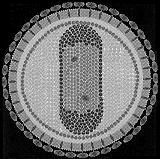Equine infectious anemia
The equine infectious anemia ( Equine Infectious Anemia (EIA), Eng. Swamp fever ) is a viral infection of horses , with a febrile anemia ( anemia associated) and usually fatal ends. Infected animals remain virus carriers for life. It is a notifiable animal disease in Germany and is on the list of the World Organization for Animal Health (OIE). The disease is enzootic in parts of Europe , America , the Middle and Far East , Russia and South Africa , but the animal disease control has made it rather rare. EIA outbreaks occur sporadically in Germany; 15 outbreaks were detected between 1993 and 2007. In 2008, another five outbreaks were reported. In December 2009 five horses from a herd in Upper Franconia and another animal, also from the same district, tested positive. Then the horses had to be killed under the supervision of the responsible veterinary office. In 2009 over 11,000 horses were affected in Romania. There is a new case in Germany in 2018 ( Hagenow , Ludwigslust district / Mecklenburg-Western Pomerania ).
Etiology and pathogenesis
The causative agent of contagious anemia in equines is the equine infectious anemia virus (EIAV) from the retrovirus family , genus lentivirus . As with other retroviruses, numerous virus variants occur due to errors in virus replication .
The EIAV was the first retrovirus to demonstrate mechanical transmission through blood-sucking insects . The disease occurs mainly in swamp areas, from which the English name ("swamp fever" = marsh fever) is derived. The virus is excreted in milk , saliva and urine , so that direct or indirect transmission via these body fluids is believed to be possible. A iatrogenic transmission through needles or surgical instruments is possible with non-sterile work.
The EIAV attacks monocytes or macrophages (including the Kupffer cells ), via which the provirus, which is integrated into the genome , is distributed in the body. Despite a strong immune reaction against the virus antigen with the formation of non-neutralizing antibodies, the provirus persists within the infected cells. The antibodies form antigen-antibody complexes that influence the complement cascade and lead to fever , anemia, thrombocytopenia and glomerulonephritis . Anemia is the result of hemolysis , phagocytosis of red blood cells ( erythrocytes ) and a decrease in the number of new red blood cells.
Clinical picture
The incubation period is two to six weeks. The disease can be acute or chronic .
The acute form manifests itself in sudden fever, fatigue, anorexia , thirst, increasing weakness, punctiform bleeding ( petechiae ) and edema in the abdominal area and ends fatally after two to four weeks.
The chronic form is more common. Here the animals show intermittent fever and anemia. You lose body mass and edema of the limbs and abdomen is common. Occasionally, movement disorders ( ataxia ) may occur, which in rare cases may be the only clinical symptom . A remission is common, and the animals may appear healthy for years. A viremia can occur over years, even in remission phases.
The disease can cause foaling in pregnant mares. The mare can also give birth to a healthy, uninfected foal.
To date, there are no statistics on the death rate from this disease. Studies suggest that there are virus tolerant breeds. Further studies on wild horses in Brazil show that around 30% of horses are chronically infected, but still lead normal lives.
diagnosis
For diagnosis are blood serum , with ataxia and cerebrospinal fluid used. The disease is detected by detecting specific antibodies against the virus protein p26. The most reliable is the agar-gel immunodiffusion test ( Coggins test ). An ELISA is also available, but should be confirmed by a Coggins test. The proviral DNA can be detected by PCR , viral RNA by RT-PCR .
Combat
A vaccination was carried out in China in the 1980s with an attenuated live vaccine, which led to extensive control of the disease there. Other vaccines are still in the experimental stage. In Europe, however, no vaccine is approved, so control is still aimed at killing infected animals. In many countries only the importation of seronegative horses is allowed.
In Germany, control is regulated by the equine anemia ordinance . Thereafter, neither vaccinations nor attempts at healing may be carried out on sick animals. In the event of an officially determined outbreak of equine anemia, a restricted area with a radius of at least one kilometer is established around the infected farm , which equines may only leave with approval after an officially determined negative examination result. As a rule, the ordinance provides for the killing of sick animals; under certain circumstances, strict isolation can be used to carry out scientific experiments.
Literature and individual references
- ↑ Information on Equine Infectious Anemia ( Memento of February 28, 2009 in the Internet Archive ), FLI
- ↑ anemia In: LAND & Forst 38/2010, p 90
- ^ Dpa: Contagious horse disease broke out in Mecklenburg. Retrieved April 5, 2018 .
- ↑ www.donblazer.com ( Memento of September 30, 2007 in the Internet Archive ) (in English)
- ↑ Jodi K. Craigo et al .: Discerning an Effective Balance between Equine Infectious Anemia Virus Attenuation and Vaccine Efficacy. In: J Virol. 79 (2005), pp. 2666–2677, PMC 548432 (free full text)
